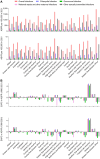Global burden of female infertility attributable to sexually transmitted infections and maternal sepsis: 1990-2021 and projections to 2050
- PMID: 40307311
- PMCID: PMC12043824
- DOI: 10.1038/s41598-025-94259-9
Global burden of female infertility attributable to sexually transmitted infections and maternal sepsis: 1990-2021 and projections to 2050
Abstract
Infectious diseases, such as sexually transmitted infections (STIs) and maternal sepsis, are major contributors to female infertility, creating a substantial burden on women of reproductive age. Based on Global Burden of Disease (GBD) 2021, this study analyzed the global trends and regional disparities in infection-related infertility for women aged 15-49 and projected future burdens. Our result showed that from 1990 to 2021, global age-standardized prevalence rate (ASPR) rose from 839.52 to 982.37 per 100,000 with estimated annual percentage change (EAPC) (0.26 [0.19 to 0.33]), and years lived with disability (YLDs) increasing from 62.81 to 106.69 thousand (EAPC 0.23 [0.16 to 0.31]), and was predicted to continue rising from 2022 to 2050. The disease burden showed significant regional disparities, low socio-demographic index (SDI) regions had the highest ASPR (1247.25 per 100,000 [1085.17 to 1443.57]) but also the fastest decline (EAPC -1.17 [-1.34 to -0.99]), and Western Sub-Saharan Africa (ASPR 1,925.52 [1655.35 to 2241.71] per 100,000) are the regions with highest burden. The disease burden increased with age, peaking at 40-44 years, and was inversely associated with SDI. These findings provide essential insights for policymakers to develop targeted strategies to prevent and control infection-related infertility, particularly in low-SDI regions.
Keywords: Global burden of disease; Infections; Infertility; Maternal sepsis; Prevalence; Sexually transmitted infections.
© 2025. The Author(s).
Conflict of interest statement
Declarations. Competing interests: The authors declare no competing interests.
Figures






Similar articles
-
Global, regional, and national prevalence and trends of infertility among individuals of reproductive age (15-49 years) from 1990 to 2021, with projections to 2040.Hum Reprod. 2025 Mar 1;40(3):529-544. doi: 10.1093/humrep/deae292. Hum Reprod. 2025. PMID: 39752330
-
Global, regional, and national burden of infertility attributable to PCOS, 1990-2019.Hum Reprod. 2024 Jan 5;39(1):108-118. doi: 10.1093/humrep/dead241. Hum Reprod. 2024. PMID: 38011904
-
Changing trends in the global burden of polycystic ovarian syndrome-related infertility over the past 30 years: retrospective data analysis of the global burden of disease study 2019.BMC Womens Health. 2025 Jan 23;25(1):35. doi: 10.1186/s12905-024-03537-7. BMC Womens Health. 2025. PMID: 39849485 Free PMC article.
-
Temporal trends in cross-country inequalities of early-onset pancreatic cancer: a comprehensive analysis for the global burden of disease study 2021.Sci Rep. 2025 Apr 28;15(1):14835. doi: 10.1038/s41598-025-93892-8. Sci Rep. 2025. PMID: 40295659 Free PMC article.
-
Burden of female infertility in 204 countries and territories, 1990-2021: results from the Global Burden of Disease Study 2021.J Psychosom Obstet Gynaecol. 2025 Dec;46(1):2459618. doi: 10.1080/0167482X.2025.2459618. Epub 2025 Feb 12. J Psychosom Obstet Gynaecol. 2025. PMID: 39936646 Review.
References
-
- Yee, L. M., Miller, E. C. & Greenland, P. Mitigating the Long-term Health Risks of Adverse Pregnancy Outcomes. JAMA327, 421–422. 10.1001/jama.2021.23870 (2022). - PubMed
-
- Yu, J. et al. Burden of female infertility in China from 1990 to 2019: a temporal trend analysis and forecasting, and comparison with the global level. Sex Health20, 577–584. 10.1071/SH23029 (2023). - PubMed
-
- Mielczarek, E. & Blaszkowska, J. Trichomonas vaginalis: pathogenicity and potential role in human reproductive failure. Infection44, 447–458. 10.1007/s15010-015-0860-0 (2016). - PubMed
MeSH terms
LinkOut - more resources
Full Text Sources
Medical

